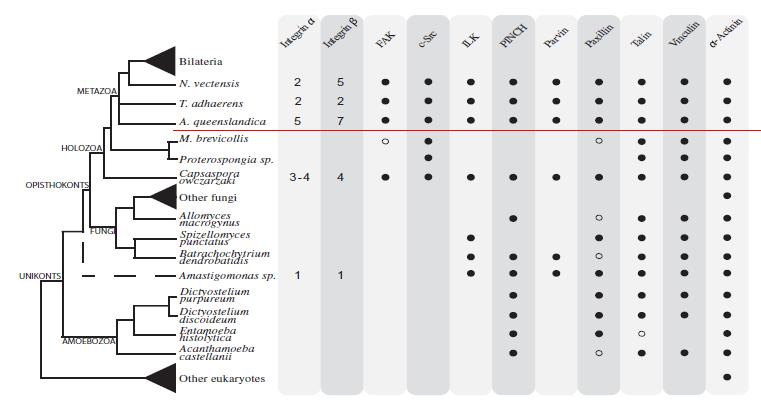What'sNEW June–Aug 2010
 24 August 2010 24 August 2010
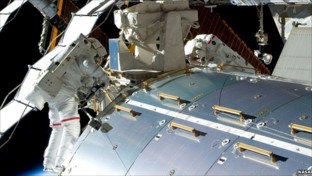 Bacteria from the South Coast of England survived 553 days' exposure to space. Similar to Gloeocapsa cyanobacteria, still in and on pieces of their native cliff rock, the bacteria were exposed as part of a European Space Agency experiment on the International Space Station (pictured). They would have been exposed to extreme ultraviolet light, cosmic rays, and dramatic shifts in temperature.... All the water in the limestone would also have boiled away into the vacuum of space. Coming from the town of Beer, these bacteria add evidence that microbial life could survive space travel, as panspermia requires.
Bacteria from the South Coast of England survived 553 days' exposure to space. Similar to Gloeocapsa cyanobacteria, still in and on pieces of their native cliff rock, the bacteria were exposed as part of a European Space Agency experiment on the International Space Station (pictured). They would have been exposed to extreme ultraviolet light, cosmic rays, and dramatic shifts in temperature.... All the water in the limestone would also have boiled away into the vacuum of space. Coming from the town of Beer, these bacteria add evidence that microbial life could survive space travel, as panspermia requires.
 Beer microbes live 553 days outside ISS by Jonathan Amos, BBC News, 23 Aug 2010. Beer microbes live 553 days outside ISS by Jonathan Amos, BBC News, 23 Aug 2010.
 Beer microbes survive the rigors of space, PhysicsCentral, American Physical Society, 23 Aug 2010. Beer microbes survive the rigors of space, PhysicsCentral, American Physical Society, 23 Aug 2010.
 Microbes survive a year and a half in space by Lin Edwards, Physorg.com, 25 Aug 2010. Microbes survive a year and a half in space by Lin Edwards, Physorg.com, 25 Aug 2010.
 Microbial Star Trekkers Survive 553 Days in Space, Discovery News, 16 Sep 2010. Microbial Star Trekkers Survive 553 Days in Space, Discovery News, 16 Sep 2010.
 Bacteria: The Space Colonists is a related local webpage. Bacteria: The Space Colonists is a related local webpage.
 More Evidence for Indigenous Microfossils... is our webpage that prompted Stuart Udall to alert us to this story. More Evidence for Indigenous Microfossils... is our webpage that prompted Stuart Udall to alert us to this story.
 Thanks Stu, and also Ron McGhee, Jerry Chancellor, Google Alerts and Stan Franklin. Thanks Stu, and also Ron McGhee, Jerry Chancellor, Google Alerts and Stan Franklin.

 18 August 2010 18 August 2010
A life-detection experiment on Mars, sent on the NASA's Viking Missions in 1976-1977, is described in detail by its inventor, Gil Levin (pictured), in videos available on the Internet. Gil believes life was detected, and he fully discusses the counter-arguments. He also suggests experiments and procedures to resolve the remaining doubts. Well worth watching!
 How the Viking Mission Found Life on Mars - Part 1,
2,
3,
4,
5 — YouTube videos posted 2010. How the Viking Mission Found Life on Mars - Part 1,
2,
3,
4,
5 — YouTube videos posted 2010.
 Life on Mars! is the related local webpage. Life on Mars! is the related local webpage.
 Thanks, Barry DiGregorio, author of "Mars: The Next Decade," p46-53 v55, Earth, Aug 2010. Thanks, Barry DiGregorio, author of "Mars: The Next Decade," p46-53 v55, Earth, Aug 2010.
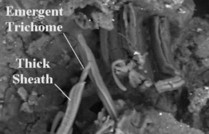
 15 August 2010 15 August 2010
More Evidence for Indigenous Microfossils in Carbonaceous Meteorites is the subject of a new webpage containing previously unpublished images of fossilized cyanobacteria in the Orgueil and Murchison meteorites. NASA scientist Richard Hoover kindly provided the images, captions, references, and most of the text.
 More Evidence for Indigenous Microfossils... is the new webpage, posted 15 Aug 2010. More Evidence for Indigenous Microfossils... is the new webpage, posted 15 Aug 2010.
 Fossilized Life Forms in the Murchison Meteorite is a related webpage, posted 29 Jul 1997. Fossilized Life Forms in the Murchison Meteorite is a related webpage, posted 29 Jul 1997.
 Fossilized Magnetotactic Bacterium in the Orgueil Meteorite is a related webpage, posted 8 Sep 1998. Fossilized Magnetotactic Bacterium in the Orgueil Meteorite is a related webpage, posted 8 Sep 1998.
 Evidence for Indigenous Microfossils in a Carbonaceous Meteorite is a related webpage, posted 2 Aug 2004. Evidence for Indigenous Microfossils in a Carbonaceous Meteorite is a related webpage, posted 2 Aug 2004.
 12 August 2010 12 August 2010
...Astrobiology XIII, a conference at the SPIE Convention in San Diego, featured many interesting presentations by astrobiologists from near and far. Some of the more famous ones were (pictured, left to right) Steven Benner, Westheimer Institute for Science and Technology; Paul Knauth, Arizona State University; Jill Tartar, SETI Institute; Charles Townes, University of California, Berkeley; and Chandra Wickramasinghe, Cardiff Astrobiology Center.
Jill Tarter opened the conference with an entertaining and informative presentation of the history of SETI. That evening, Charles Townes moderated a panel discussion open to the public, "Life in the Cosmos". The next day, Chandra Wickramasinghe talked about cometary panspermia from his unique perspective as a pioneer and founder. Paul Knauth gave a presentation entitled, "Astrobiology in a salty universe" that we found most edifying. And Steven Benner dazzled the audience with fanciful molecular biology involving, for example, six, instead of four, genetic nucleotides. When we asked Benner if he expected the origin of life to be understood and demonstrated during his lifetime, he did not say yes, in spite of his declaration, "I plan to live forever."
The most interesting part of all, to us, was Conference Chair Richard Hoover's presentation of his continuing discoveries of fossilized bacteria in carbonaceous meteorites like Murchison and Orgueil. We will describe them on a new webpage soon. [Done  ] ]
 Instruments, Methods, and Missions for Astrobiology XIII, San Diego, CA, 3-5 Aug 2010. Instruments, Methods, and Missions for Astrobiology XIII, San Diego, CA, 3-5 Aug 2010.
 2010 SPIE Life in the Cosmos Panel [local PDF], has bios and photos of most of the above conference participants, and others. 2010 SPIE Life in the Cosmos Panel [local PDF], has bios and photos of most of the above conference participants, and others.
 4 August 2010 4 August 2010
Sponges have many genes that are used only by more advanced animals for encoding organs, nerves and muscles. This observation comes from a report by an international multidisciplinary team who sequenced the genome of Amphimedon queenslandica (pictured), a demosponge found on the Great Barrier Reef. Sponges have flourished on Earth for at least 635 million years, since before life on Earth had nerves, muscles, or complex organs. The apparent early presence of these advanced genes is a big surprise. Nature comments —
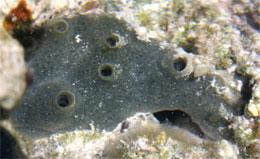
 With more than 18,000 individual genes, the sponge genome represents a diverse toolkit, coding for many processes that lay the foundations for more complex creatures. These include... analogues of genes that, in organisms with a neuromuscular system, code for muscle tissue and neurons. With more than 18,000 individual genes, the sponge genome represents a diverse toolkit, coding for many processes that lay the foundations for more complex creatures. These include... analogues of genes that, in organisms with a neuromuscular system, code for muscle tissue and neurons.
 Douglas Erwin, a palaeobiologist at the Smithsonian Institution in Washington DC, remarks, This flies in the face of what we think of early metazoan evolution. Douglas Erwin, a palaeobiologist at the Smithsonian Institution in Washington DC, remarks, This flies in the face of what we think of early metazoan evolution.
 Charles Marshall, director of the University of California Museum of Paleontology in Berkeley, agrees. What I want to know now is what were all these genes doing prior to the advent of sponge. Charles Marshall, director of the University of California Museum of Paleontology in Berkeley, agrees. What I want to know now is what were all these genes doing prior to the advent of sponge.
The report itself states —
 Comparative analysis enabled by the sequencing of the sponge genome reveals genomic events linked to the origin and early evolution of animals, including the appearance, expansion and diversification of pan-metazoan transcription factor, signalling pathway and structural genes. This diverse 'toolkit' of genes correlates with critical aspects of all metazoan body plans, and comprises cell cycle control and growth, development, somatic- and germ-cell specification, cell adhesion, innate immunity and allorecognition. Comparative analysis enabled by the sequencing of the sponge genome reveals genomic events linked to the origin and early evolution of animals, including the appearance, expansion and diversification of pan-metazoan transcription factor, signalling pathway and structural genes. This diverse 'toolkit' of genes correlates with critical aspects of all metazoan body plans, and comprises cell cycle control and growth, development, somatic- and germ-cell specification, cell adhesion, innate immunity and allorecognition.
 The A. queenslandica genome harbours an extensive repertoire of developmental signalling and transcription factor genes, indicating that the metazoan ancestor had a developmental 'toolkit' similar to that of modern complex bilaterians. The origins of many of these and other genes specific to animal processes such as cell adhesion, and social control of cell proliferation, death and differentiation can be traced to genomic events (gene birth, subfamily expansions, intron gain/loss, and so on) that occurred in the lineage that led to the metazoan ancestor, after animals diverged from their unicellular 'cousins'. [The actual "events" to which these "origins" can be "traced" are not at all clear in darwinan theory. What is "gene birth"? The genes, whole or in a few pieces, are simply there, ready for assembly and deployment.] The A. queenslandica genome harbours an extensive repertoire of developmental signalling and transcription factor genes, indicating that the metazoan ancestor had a developmental 'toolkit' similar to that of modern complex bilaterians. The origins of many of these and other genes specific to animal processes such as cell adhesion, and social control of cell proliferation, death and differentiation can be traced to genomic events (gene birth, subfamily expansions, intron gain/loss, and so on) that occurred in the lineage that led to the metazoan ancestor, after animals diverged from their unicellular 'cousins'. [The actual "events" to which these "origins" can be "traced" are not at all clear in darwinan theory. What is "gene birth"? The genes, whole or in a few pieces, are simply there, ready for assembly and deployment.]
 From these observations we infer that the metazoan ancestor possessed a complex sensory system, and many of the molecular requirements for neural development and nerve cell function. ...These genomic comparisons reconstruct a common animal ancestor of remarkable complexity. [No other evidence supports this new inference.] From these observations we infer that the metazoan ancestor possessed a complex sensory system, and many of the molecular requirements for neural development and nerve cell function. ...These genomic comparisons reconstruct a common animal ancestor of remarkable complexity. [No other evidence supports this new inference.]
The existence of genes before they are deployed is a jarring puzzle for strict darwinism. The most logical darwinian workaround is ad hoc, unsupported by any other evidence. In the current report the anomaly is glossed over with reference to unseen, unspecified "events". Even without a competing theory, these failings should not be overlooked.
In cosmic ancestry, genes must exist before they are deployed. By horizontal gene transfer (HGT), they can arrive where they may be useful. The "toolkit" in the sponge genome powerfully supports this claim.
 Mansi Srivastava et al., "The Amphimedon queenslandica genome and the evolution of animal complexity" [html], doi:10.1038/nature09201, p720-726 v466, Nature, 5 Aug 2010. Mansi Srivastava et al., "The Amphimedon queenslandica genome and the evolution of animal complexity" [html], doi:10.1038/nature09201, p720-726 v466, Nature, 5 Aug 2010.
 Adam Mann, "Sponge genome goes deep" [html], doi:10.1038/466673a, p673 v466, Nature, 5 Aug 2010. Adam Mann, "Sponge genome goes deep" [html], doi:10.1038/466673a, p673 v466, Nature, 5 Aug 2010.
 Viruses and Other Gene Transfer Mechanisms is the main local webpage about gene transfer. Viruses and Other Gene Transfer Mechanisms is the main local webpage about gene transfer.
What'sNEW about HGT  | |
 Metazoan Genes Older Than Metazoa? is a related local webpage. Metazoan Genes Older Than Metazoa? is a related local webpage.
 Thanks, Hans-Peter Wheeler. Thanks, Hans-Peter Wheeler.
 30 July 2010 30 July 2010
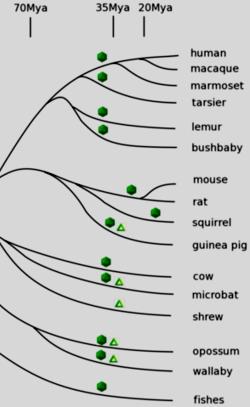 The human genome is loaded with endogenous retroviruses. Until recently, retroviruses were thought to be the only kind of virus able to become endogenous in humans. But lately, examples of integrated non-retroviral RNA viruses have been found in humans and other vertebrates. Now three biologists in Princeton NJ have conducted a systematic search for such integrations among 48 vertebrate genomes. They specifically queried for sequences derived from 5,666 known RNA viruses, including the Marburg and Ebola viruses that can cause fatal diseases.
The human genome is loaded with endogenous retroviruses. Until recently, retroviruses were thought to be the only kind of virus able to become endogenous in humans. But lately, examples of integrated non-retroviral RNA viruses have been found in humans and other vertebrates. Now three biologists in Princeton NJ have conducted a systematic search for such integrations among 48 vertebrate genomes. They specifically queried for sequences derived from 5,666 known RNA viruses, including the Marburg and Ebola viruses that can cause fatal diseases.
The three 'were floored' by the results.... Nineteen of the species, including a squirrel, a small bat, a zebrafish, and a human had RNA viral sequences embedded in their DNA. But equally intriguing was how few different families of RNA viruses turned up: just Bornaviruses and Filoviruses [designated by hexagons and triangles, respectively, in figure]. 'It's a mystery as to why this should be.' ...The integrations happened as long as 40 million years ago, the team reports today in PLOS Pathogens.
The report comments, The conservation of relatively long open reading frames for several of the endogenous sequences, the virus-like protein regions represented, and a potential correlation between their presence and a species' resistance to the diseases caused by these pathogens, are consistent with the notion that their products provide some important biological advantage to the species.
Examples of viruses that become integrated into host genomes are consistent with cosmic ancestry, in which new genetic programs must be acquired by some form of gene transfer. Such examples are accumulating rapidly, and the current report only adds more.
 Vladimir A. Belyi, Arnold J. Levine and Anna Marie Skalka, "Unexpected Inheritance: Multiple Integrations of Ancient Bornavirus and Ebolavirus/Marburgvirus Sequences in Vertebrate Genomes" [html], doi:10.1371/journal.ppat.1001030, PLoS Pathog 6(7): e1001030, Jul 2010. Vladimir A. Belyi, Arnold J. Levine and Anna Marie Skalka, "Unexpected Inheritance: Multiple Integrations of Ancient Bornavirus and Ebolavirus/Marburgvirus Sequences in Vertebrate Genomes" [html], doi:10.1371/journal.ppat.1001030, PLoS Pathog 6(7): e1001030, Jul 2010.
 Deadly Viruses Have Been Part of Us for Millions of Years by Jennifer Couzin-Frankel, ScienceNow, 29 Jul 2010. Deadly Viruses Have Been Part of Us for Millions of Years by Jennifer Couzin-Frankel, ScienceNow, 29 Jul 2010.
 Unexpected Viral 'Fossils' Found in Vertebrate Genomes, ScienceDaily, 30 Jul 2010. Unexpected Viral 'Fossils' Found in Vertebrate Genomes, ScienceDaily, 30 Jul 2010.
 Viruses and Other Gene Transfer Mechanisms is the main local webpage about gene transfer. Viruses and Other Gene Transfer Mechanisms is the main local webpage about gene transfer.
What'sNEW about HGT  | |
 ...[A] new mechanism for how mammals acquire genes is a related What'sNEW article, 4 Jul 2010. ...[A] new mechanism for how mammals acquire genes is a related What'sNEW article, 4 Jul 2010.
 23 July 2010 23 July 2010
The cell, and indeed evolution, can dial up these microRNAs very flexibly in different cells to address various targets, and they only need one protein complex to come and do the job. These words come from an interview with molecular biologist John Mattick (pictured) of the University of Queensland, Australia. Originally curious about introns, he thinks that non-coding RNAs have important, highly specific regulatory functions; and that much of the genetic programming in higher eukaryotes is contained, not only in protein-coding genes, but in these non-coding RNAs. Asked "...Why postulate regulatory RNA?," he answers —
 "There are a few key points. The first - and this is one of the great surprises of the genome projects, that very few people have commented on because of their background assumptions - is that both the number and range of protein-coding genes have remained largely the same since the base of the metazoan radiation. Caenorhabditis elegans, which is a worm of only 1,000 cells, has almost precisely the same number of protein-coding genes as a human - about 20,000 is the latest estimate - and most of those genes encode similar functions. So the basic parts set for animal development was established several hundred million years ago. In fact, I understand the sponge genome also encodes most, if not all, of the key protein families that are involved in regulating development. Now C. elegans has only got 1,000 cells - a few muscle cells, a few nerve cells, and a gut. We humans have 30 trillion to 100 trillion cells, and the complexity of our body plan organization - including all of the muscles in the face that reflect the range of human emotions, the different bones and organs, and the brain - is enormous."
"There are a few key points. The first - and this is one of the great surprises of the genome projects, that very few people have commented on because of their background assumptions - is that both the number and range of protein-coding genes have remained largely the same since the base of the metazoan radiation. Caenorhabditis elegans, which is a worm of only 1,000 cells, has almost precisely the same number of protein-coding genes as a human - about 20,000 is the latest estimate - and most of those genes encode similar functions. So the basic parts set for animal development was established several hundred million years ago. In fact, I understand the sponge genome also encodes most, if not all, of the key protein families that are involved in regulating development. Now C. elegans has only got 1,000 cells - a few muscle cells, a few nerve cells, and a gut. We humans have 30 trillion to 100 trillion cells, and the complexity of our body plan organization - including all of the muscles in the face that reflect the range of human emotions, the different bones and organs, and the brain - is enormous."
Genetic subroutines that can be "dialed up" are consistent with our belief that genetic programs and subroutines must be ready for use before they are activated, and not composed de novo during ongoing trials. Indeed, trial-and-error is still needed in cosmic ancestry, but it can only select and optimise among existing genetic programs. Mattick's idea is that the basic parts - proteins - are the same for all of higher life, but regulatory systems can use them to make more complex creatures as evolution proceeds. He also thinks transposons can insert and relocate the regulators. "So it's equally possible that a large fraction of the transposon-derived sequences that are in our genome are actually functional." We agree.
If genetic programs and subroutines are acquired, there must be software management systems capable of properly installing them for testing, and transposons are likely components of such systems. But the details are not yet clear, to say the least. Meanwhile, Mattick's insights about non-coding RNAs seem promising.
 John Mattick [edited transcript of an open-access interview], "Non-coding RNAs and eukaryotic evolution..." [html], doi:10.1186/1741-7007-8-67, v8 n67, BMC Biology, online 16 Jul 2010. John Mattick [edited transcript of an open-access interview], "Non-coding RNAs and eukaryotic evolution..." [html], doi:10.1186/1741-7007-8-67, v8 n67, BMC Biology, online 16 Jul 2010.
 Miranda Robertson, "The evolution of gene regulation, the RNA universe, and the vexed questions of artefact and noise" [html], doi:10.1186/1741-7007-8-97, v8 n97, BMC Biology, online 16 Jul 2010. Miranda Robertson, "The evolution of gene regulation, the RNA universe, and the vexed questions of artefact and noise" [html], doi:10.1186/1741-7007-8-97, v8 n97, BMC Biology, online 16 Jul 2010.
 Viruses and Other Gene Transfer Mechanisms is a related local webpage. Viruses and Other Gene Transfer Mechanisms is a related local webpage.
What'sNEW about HGT  | |
 Introns: a Mystery is a related local webpage. Introns: a Mystery is a related local webpage.
 Metazoan Genes Older Than Metazoa? is a related local webpage. Metazoan Genes Older Than Metazoa? is a related local webpage.
 Conserved Non-Genic Sequences is a related local webpage. Conserved Non-Genic Sequences is a related local webpage.
 Robust Software Management is a new webpage (added 2015) for exploration of this subject. Robust Software Management is a new webpage (added 2015) for exploration of this subject.
 19 July 2010 19 July 2010
Such high survival rates reinforce the possibility of an interplanetary transfer of viable microbes. This conclusion comes from a Brazilian team who exposed the radiation-resistant bacterium Deinococcus radiodurans to simulated interplanetary UV radiation at the Brazilian Synchrotron Light Laboratory. When cells were shielded by layers of other cells, their survival rate remained constant for a wide range of doses. Apparently there are four copies of the genome, so the bacterium could restore a damaged strand to match an undamaged one. This redundancy suggests that at least some cells would survive despite long exposure to UV radiation in space.
 Ivan Gláucio Paulino-Lima et al., "Laboratory simulation of interplanetary ultraviolet radiation (broad spectrum) and its effects on Deinococcus radiodurans" [abstract], p1180-1187 v58, Planetary and Space Science, Aug 2010. Ivan Gláucio Paulino-Lima et al., "Laboratory simulation of interplanetary ultraviolet radiation (broad spectrum) and its effects on Deinococcus radiodurans" [abstract], p1180-1187 v58, Planetary and Space Science, Aug 2010.
 Jonathan Leake, "'Conan' bug may be source of life," p7, The Sunday Times (London), 18 Jul 2010. Jonathan Leake, "'Conan' bug may be source of life," p7, The Sunday Times (London), 18 Jul 2010.
 Bacteria: The Space Colonists is a related local webpage. Bacteria: The Space Colonists is a related local webpage.
 Thanks, Martin Langford. Thanks, Martin Langford.
 18 July 2010 18 July 2010
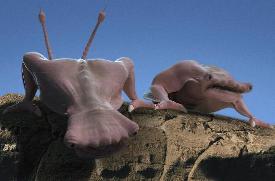 Life on other worlds is the subject of Stephen Hawking's imagination in a recent television program on the Discovery Channel. Using computer graphics, Hawking depicts how life might look in Europa's ice-covered ocean, on gas giants, on cold windy planets and even in free space. Some of the imagined aliens have familiar features such as paired eyes and limbs. Believing that all life in the cosmos is related, we think that such similarities are appropriate.
Life on other worlds is the subject of Stephen Hawking's imagination in a recent television program on the Discovery Channel. Using computer graphics, Hawking depicts how life might look in Europa's ice-covered ocean, on gas giants, on cold windy planets and even in free space. Some of the imagined aliens have familiar features such as paired eyes and limbs. Believing that all life in the cosmos is related, we think that such similarities are appropriate.
 Into the Universe with Stephen Hawking, Discovery Channel, aired 11 Jul 2010. Into the Universe with Stephen Hawking, Discovery Channel, aired 11 Jul 2010.
 Stephen Hawking wants you to meet the neighbours - they're a bit odd, The Daily Telegraph (Sidney, Australia), 9 Jul 2010. Stephen Hawking wants you to meet the neighbours - they're a bit odd, The Daily Telegraph (Sidney, Australia), 9 Jul 2010.
 Life on Europa, Other Moons, Other Planets? is a related local webpage. Life on Europa, Other Moons, Other Planets? is a related local webpage.
 Stephen Hawking endorses panspermia in a related What'sNEW article, 7 Apr 2009. Stephen Hawking endorses panspermia in a related What'sNEW article, 7 Apr 2009.
 Thanks, Stan Franklin. Thanks, Stan Franklin.
 18 July 2010 18 July 2010
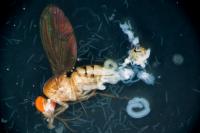 Infecting microbes can confer parasite resistance in fruitflies, according to a team at the University of Rochester. Roundworms cause sterility in the fruitflies (see figure), but when a female fly is also infected with a bacteria species called Spiroplasma, the nematodes grow poorly and no longer sterilize the flies.... This symbiotic relationship between host animal and bacteria gives the host animal a readymade defense against a hazard in its environment and thus has spread through the population by natural selection, the way a favorable gene would.
Infecting microbes can confer parasite resistance in fruitflies, according to a team at the University of Rochester. Roundworms cause sterility in the fruitflies (see figure), but when a female fly is also infected with a bacteria species called Spiroplasma, the nematodes grow poorly and no longer sterilize the flies.... This symbiotic relationship between host animal and bacteria gives the host animal a readymade defense against a hazard in its environment and thus has spread through the population by natural selection, the way a favorable gene would. In this case there is no integration of new genes into the nuclear genome of the host, but the evolutionary effect is similar. Rochester calls it a new mechanism for evolution. From our perspective, it is a surprising example of evolution by the [indirect] acquisition of genes [within bacteria] from elsewhere.
 Alternative Evolution: Why Change Your Own Genes When You Can Borrow Someone Else's?, University of Rochester News (also Newswise), 8 Jul 2010. Alternative Evolution: Why Change Your Own Genes When You Can Borrow Someone Else's?, University of Rochester News (also Newswise), 8 Jul 2010.
 Wednesday, 14 July 2010 Wednesday, 14 July 2010
 The ESA space probe Rosetta flew past the Lutetia planetoid at around 6 p.m. CEST on Saturday. The OSIRIS camera system, built and developed under the direction of the Max Planck Institute for Solar System Research... provided unique images of this rendezvous. They not only show a large number of craters on the surface of the celestial body, but also individual rocks and parallel grooves.
The ESA space probe Rosetta flew past the Lutetia planetoid at around 6 p.m. CEST on Saturday. The OSIRIS camera system, built and developed under the direction of the Max Planck Institute for Solar System Research... provided unique images of this rendezvous. They not only show a large number of craters on the surface of the celestial body, but also individual rocks and parallel grooves.
With a resolution of around 60 metres per pixel, the images provide a fascinating view of Lutetia.... The planetoid, whose longest axis measures around 126 kilometres, is oval in shape. Its surface is marked by many craters, both large and small.... In some parts, parallel grooves cover the cosmic rock, the origin of which is still unknown.
This is not the first small asteroid, moon or planetoid seen to have parallel grooves. Others include Phoebe and Eros. On Earth, parallel layers in rock are sedimenary deposits formed on the floors of lakes or oceans. We wonder, could Lutetia and the others be fragments of larger bodies where layers of sediment formed in a similar manner?
 Fascinating images from a new world, Max Planck Society for the Advancement of Science, 14 Jul 2010. Fascinating images from a new world, Max Planck Society for the Advancement of Science, 14 Jul 2010.
 Phoebe: Comet Moon of Saturn, Astronomy Picture of the Day, 12 Feb 2006. Phoebe: Comet Moon of Saturn, Astronomy Picture of the Day, 12 Feb 2006.
 Asteroid Eros Reconstructed, Astronomy Picture of the Day, 7 Jun 2009; and a mosaic taken August 20, 2000. Asteroid Eros Reconstructed, Astronomy Picture of the Day, 7 Jun 2009; and a mosaic taken August 20, 2000.
 Phobos... from Mars Express, Astronomy Picture of the Day, 24 Jan 2011. Phobos... from Mars Express, Astronomy Picture of the Day, 24 Jan 2011. 
 Life on Europa, Other Moons, Other Planets? is a local webpage with links to related stories. Life on Europa, Other Moons, Other Planets? is a local webpage with links to related stories.
 Comet Rendezvous is related section of our webpage "Can the Theory Be Tested," with more about Rosetta. Comet Rendezvous is related section of our webpage "Can the Theory Be Tested," with more about Rosetta.
 11 July 2010 11 July 2010
...When misinformed people... were exposed to corrected facts... they rarely changed their minds. In fact, they often became even more srongly set in their beliefs, according to a series of studies at the University of Michigan.
 Joe Keohane, "How Facts Backfire" [link], pC1-C3, The Boston Globe, 11 Jul 2010. Joe Keohane, "How Facts Backfire" [link], pC1-C3, The Boston Globe, 11 Jul 2010.
 4th of July 2010 4th of July 2010
...[A] new mechanism for how mammals acquire genes is announced by biologists from The University at Buffalo who found "fossil" virus genes among wallabies, bats and other mammals. The viruses are known to cause "Ebola and Marburg hemorrhagic fevers and are the most lethal viruses known to humans." Yet they cause no obvious symptoms among the non-human mammals that harbor them. It is also interesting that wallabies are Australian and not known to have colonized Africa, where the viruses are widespread.
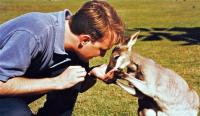
"The research also demonstrates a new mechanism by which different species of mammals can acquire genes, through non-retroviral integrated RNA viruses, which the UB scientists had previously identified in eukaryotes but was unknown in mammals." (We thought it was already known.) "The research also reveals that existing estimates that filoviruses originated in mammals a few thousand years ago were way off the mark." The researchers think the viruses could be as old as mammals, or over 200 million years old.
 Derek J. Taylor et al., "Filoviruses are ancient and integrated into mammalian genomes" [abstract], doi:10.1186/1471-2148-10-193, v10 paper 193, BMC Evolutionary Biology, 22 Jun 2010. Derek J. Taylor et al., "Filoviruses are ancient and integrated into mammalian genomes" [abstract], doi:10.1186/1471-2148-10-193, v10 paper 193, BMC Evolutionary Biology, 22 Jun 2010.
 Wallabies and Bats Harbor "Fossil" Genes from the Most Deadly Family of Human Viruses, University at Buffalo, 28 Jun (also Technozoic, 4 Jul) 2010. Wallabies and Bats Harbor "Fossil" Genes from the Most Deadly Family of Human Viruses, University at Buffalo, 28 Jun (also Technozoic, 4 Jul) 2010.
 Viruses and Other Gene Transfer Mechanisms is the main related local webpage. Viruses and Other Gene Transfer Mechanisms is the main related local webpage.
What'sNEW about HGT  | |
 Metazoan Genes Older Than Metazoa? is a local webpage with more examples of genes older than they were expected to be. Metazoan Genes Older Than Metazoa? is a local webpage with more examples of genes older than they were expected to be.
 19 Jan 2009: Nonretroviral RNA viruses may have contributed more substantially and directly to the evolution of mammalian genomes than has been assumed so far. 19 Jan 2009: Nonretroviral RNA viruses may have contributed more substantially and directly to the evolution of mammalian genomes than has been assumed so far.
 7 Jan 2010: A gene from a non-retroviral virus has been integrated into various mammalian genomes, including our own. 7 Jan 2010: A gene from a non-retroviral virus has been integrated into various mammalian genomes, including our own.
 Thanks, Jim Galasyn. Thanks, Jim Galasyn.
 29 June 2010 29 June 2010
...The problem is that the source of novelty is so dammed elusive. Most genes don't change very much at all, even the body-plan genes seem to be very similar in the mouse and blue whale. Or, to compare even less similar creatures: a mouse gene essential for building the eye can be inserted into the fruit fly to produce a fly eye! This refutes a key prediction of Neo-Darwinism, Ernst's Mayr's statement that it would be futile to look for similar genes in different creatures. So comments Peter Forbes in a review of What Darwin Got Wrong. We think Forbes' insight about today's theory of evolution points to problems that are best overcome by cosmic ancestry.
 Did Charles Darwin get it wrong? by Peter Forbes, The Independent, London, 29 Jan 2010. Did Charles Darwin get it wrong? by Peter Forbes, The Independent, London, 29 Jan 2010.
 2010 Jun 13: Our own review of What Darwin Got Wrong | and 2010 Jun 13: Our own review of What Darwin Got Wrong | and  correspondence with coauthor Jerry Fodor, begining 14 Jun 2010. correspondence with coauthor Jerry Fodor, begining 14 Jun 2010.
...One of the most dramatic possibilities is that elements of DNA have entered the germline from viruses. Putting this together with Margulis's ideas on the evolution of the ancestral single cell, we can see that viruses and bacteria are starting to loom very large in the picture of evolution. This comes from same review by Forbes. Like we been sayin'!
 Viruses and Other Gene Transfer Mechanisms is the main related local webpage. Viruses and Other Gene Transfer Mechanisms is the main related local webpage.
What'sNEW about HGT  | |
 Why Sexual Reproduction? is a local webpage with discussion of Lynn Margulis and symbiosis. Why Sexual Reproduction? is a local webpage with discussion of Lynn Margulis and symbiosis.
 23 June 2010 23 June 2010
The Independent Evolution of Multicellularity, a new Cosmic Ancestry webpage, deconstructs the language in a recent research article following the sequencing of the Ectoparus genome. The article purports to corroborate darwinian evolution, but it does not. This failure is common, we believe.
 The Independent Evolution of Multicellularity, the new CA webpage, 23 Jun 2010. The Independent Evolution of Multicellularity, the new CA webpage, 23 Jun 2010.
 22 June 2010 22 June 2010
...Many steps in all origin-of-life scenarios remain obscure.... It seems clear that at best a few base-camps have been established in an ascent to a still-invisible summit.
 Christopher F. Chyba, "Countering the Early Faint Sun" [summary], doi:10.1126/science.1189196, p1238-1239 v328, Science, 4 Jun 2010. Christopher F. Chyba, "Countering the Early Faint Sun" [summary], doi:10.1126/science.1189196, p1238-1239 v328, Science, 4 Jun 2010.
 The RNA World is the main local webpage about origin-of-life theories. The RNA World is the main local webpage about origin-of-life theories.
 22 June 2010 22 June 2010
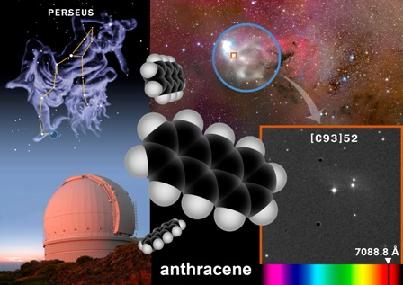 We have detected the presence of anthracene molecules in a dense cloud... about 700 light years from the Sun, says Susana Iglesias Groth of the Instituto Astrofísica de Canarias. Astronomers from there and the University of Texas have studied the cloud closely; two years ago they detected another organic molecule, naphthalene, in it. Their press release calls anthracene "one of the most complex organic molecules yet found in... the interstellar medium." And they comment, as if it were well-known, "Molecules like anthracene are prebiotic."
We have detected the presence of anthracene molecules in a dense cloud... about 700 light years from the Sun, says Susana Iglesias Groth of the Instituto Astrofísica de Canarias. Astronomers from there and the University of Texas have studied the cloud closely; two years ago they detected another organic molecule, naphthalene, in it. Their press release calls anthracene "one of the most complex organic molecules yet found in... the interstellar medium." And they comment, as if it were well-known, "Molecules like anthracene are prebiotic." But strictly nonbiological ways to make lots of complex organic molecules in space-like environments seem contrived. On Earth, large quantities of such molecules are always "post-biotic." We think the growing evidence for complex organic molecules in space may indicate that life is abundant out there.
 S. Iglesias Groth et al., "Anthracene cations toward the Perseus molecular complex", Monthly Notices of the Royal Astronomical Society, in press. S. Iglesias Groth et al., "Anthracene cations toward the Perseus molecular complex", Monthly Notices of the Royal Astronomical Society, in press.
 S. Iglesias-Groth et al., "A search for interstellar anthracene toward the Perseus anomalous microwave emission region" [preprint abstract], arXiv:1005.4388v1 [astro-ph.GA], 24 May 2010. S. Iglesias-Groth et al., "A search for interstellar anthracene toward the Perseus anomalous microwave emission region" [preprint abstract], arXiv:1005.4388v1 [astro-ph.GA], 24 May 2010.
 Super-complex organic molecules found in interstellar space, Royal Astronomical Society (also PhysOrg.com), 21 Jun 2010. Super-complex organic molecules found in interstellar space, Royal Astronomical Society (also PhysOrg.com), 21 Jun 2010.
 Hoyle and Wickramasinghe's Analysis of Interstellar Dust is a related local webpage. Hoyle and Wickramasinghe's Analysis of Interstellar Dust is a related local webpage.
 Thanks, Stan Franklin. Thanks, Stan Franklin.
 15 June 2010 15 June 2010
 Our findings lend credence to the hypothesis that an ocean formed on early Mars as part of a global and active hydrosphere. This is the conclusion of a pair of planetary geologists who analysed the distribution and elevation of 52 dry river deltas on Mars. Most of them were close to each other in elevation, and a plausible shoreline could be drawn to link them. This evidence supports the inference that Mars' northern hemisphere was once covered by an ocean — which strengthens the case for past life on Mars.
Our findings lend credence to the hypothesis that an ocean formed on early Mars as part of a global and active hydrosphere. This is the conclusion of a pair of planetary geologists who analysed the distribution and elevation of 52 dry river deltas on Mars. Most of them were close to each other in elevation, and a plausible shoreline could be drawn to link them. This evidence supports the inference that Mars' northern hemisphere was once covered by an ocean — which strengthens the case for past life on Mars.
 Gaetano Di Achille and Brian M. Hynek, "Ancient ocean on Mars supported by global distribution of deltas and valleys" [abstract], doi:10.1038/ngeo891, Nature Geoscience, online 13 Jun 2010. Gaetano Di Achille and Brian M. Hynek, "Ancient ocean on Mars supported by global distribution of deltas and valleys" [abstract], doi:10.1038/ngeo891, Nature Geoscience, online 13 Jun 2010.
 River deltas hint at ancient Martian ocean by Jon Cartwright, doi:10.1038/news.2010.293, NatureNews, 13 Jun 2010. River deltas hint at ancient Martian ocean by Jon Cartwright, doi:10.1038/news.2010.293, NatureNews, 13 Jun 2010.
 Did a Deep Sea Once Cover Mars? by Richard A. Kerr, ScienceNow, 13 Jun 2010. Did a Deep Sea Once Cover Mars? by Richard A. Kerr, ScienceNow, 13 Jun 2010.
 Life on Mars! is a related local webpage. Life on Mars! is a related local webpage.
 13 June 2010 13 June 2010
I have often wondered why philosophers-of-science do not take a more active role in the debates about evolution. In What Darwin Got Wrong, Jerry Fodor and Massimo Piattelli-Palmarini have done it. This pair of cognitive scientists with philosophy and physics backgrounds are willing to discuss the major shortcomings they see in today's theory of evolution from a philosophy-of-science perspective. In brief, they believe that natural selection cannot accomplish all that darwinists claim, and that this objection can be proven by logic.
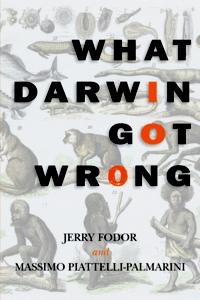
Their interest begins in psychology, where B.F. Skinner's stimulus-response theory was influential for decades. That theory was replaced, they say, because of flaws that are closely analogous to flaws in the theory of natural selection. Being little-read in psychology, I did not scrutinize these analogies. I became very alert, however, to the argument from logic that natural selection is inadequate for the task darwinism assigns it.
The logical problem arises, they say, because adaptive traits are usually linked with nonadaptive ones they call "free-riders" — Gould and Lewontin's "spandrels." When traits are linked, darwinian theory cannot demonstrate which trait was actually the one "selected for." Furthermore, reconstructive tests of traits in isolation — "counterfactuals" — are not possible. The authors argue that this situation is lethal for the theory of natural selection, leaving it "empty."
| Prima facie, free riding is a counterexample to natural selection.... As far as we can see this objection to natural selection is decisive. |
I am strongly inclined to agree. Yet even I am not convinced by this argument. (I think natural selection can work like artificial selection, whose limits point to another fundamental problem.) I am still puzzling over their logic. Having read four negative or ambivalent reviews (before reading the book!), I see no one else who finds this argument as compelling as Fodor and Piattelli-Palmarini do. I will stay tuned for possible clarification.
Critics comment that What Darwin Got Wrong deconstructs an out-of-date version of darwinism. Today's version no longer holds that mere point mutations and ultra-gradual change can produce the life around us. It has been amended far beyond that, the critics say. Okay, what are the details of the amended theory? You could say that this pair of darwinists are only prodding their fellows to take the amendment project more seriously and produce some details. But this prodding is answered with the cat-calling and mud-slinging usually reserved for arguments from creationism/ID. It is a crime, apparently, to openly discuss darwinism's need for amendments.
One thing philosophy can contribute to science is to make sure the right question is being asked. Fodor and Piattelli-Palmarini say, "...What evolutionary theory is supposed to do [is] explain how phenotypic traits are distributed in populations of organisms" (p 110). Elsewhere they ask simply "why there are the phenotypes there are" (p 148). The obvious answer is, because there are the genotypes there are. Fortunately, the authors are fairly well-informed about genomics; they even include a brief discussion of horizontal gene transfer (p 67-69). But they treat all of genomics as merely one of several specialties where amendments to darwinism might arise. I wish they would pursue the genomics angle more directly. For example, "We think the thesis that organisms are random generators of phenotypes can't be sustained even as a first approximation to an explanation of why there are the phenotypes there are" (p 160-161). Phenotypes come from genotypes, so, logically, ...organisms as random generators of genotypes can't be sustained? In that case, where do the genotypes come from? Could they fruitfully follow this thread?
They almost take the hint by insisting that exogenous factors — the environment — cannot be the only thing responsible for shaping life. There must also be endogenous factors — ones that come from within a given species — that also contribute to evolution. I wonder, could genetic progams acquired by horizontal gene transfer provide the endogenous ingredients they need? Am I taking them too literally?
And they observe, "...Before any phenotype can be, so to speak, 'offered' to selection by the environment, a host of internal constraints have to be satisfied and... interactions at many levels have to be stabilized. A variety of filters, some acting in series, some cooperating or interfering, stand between mutations and their expression" (p 39). Could the genomic software management systems that cosmic ancestry requires provide major parts of the needed "internal constraints?"
Later, they comment, "...Extant and extinct life forms are a very tiny subset of what is possible in the abstract" (p 92). I agree that this discrepancy presents major unanswered empirical questions for darwinism. In cosmic ancestry it is an issue of a different sort, perhaps similar to "why is the ratio of gravitational to electrical force what it is and not otherwise?"
Fodor and Piattelli-Palmarini conclude the main text with the words, "...There isn't any theory of evolution" (p 152). Strong words! And they do not propose any specific alternative. However, as Thomas Kuhn points out in The Structure of Scientific Revolutions, no scientific theory ever simply falls of its own weight. It must be replaced by a theory perceived to be better. Unfortunately, without offering a better theory, this pair of thoughtful scientists may go unrewarded for their courage.
Meanwhile, I cannot even claim courage. Being outside the scientific establishment, I risk very little by promoting cosmic ancestry. On the other hand, for the list of problems described in What Darwin Got Wrong, cosmic ancestry provides answers. And it allows darwinian natural selection to explain the development of life on Earth, after life arrives, with all of the genetic programming it may express. I think cosmic ancestry is a better theory that could replace the failed parts of darwinism. But it requires us to question a basic assumption — that life can make sustained macroevolutionary progress in a closed system. Would Jerry Fodor and Massimo Piattelli-Palmarini be willing to go that far? I'll ask them!
 Jerry Fodor and Massimo Piattelli-Palmarini, What Darwin Got Wrong [publisher's promo], Farrar, Straus and Giroux, ISBN: 978-0-374-28879-2, ISBN10: 0-374-28879-8, 16 Feb 2010. Jerry Fodor and Massimo Piattelli-Palmarini, What Darwin Got Wrong [publisher's promo], Farrar, Straus and Giroux, ISBN: 978-0-374-28879-2, ISBN10: 0-374-28879-8, 16 Feb 2010.
 Douglas J. Futuyma, "Two Critics Without a Clue" [link], doi:10.1126/science.1189090, p692-693 v328, Science, 7 May 2010. Douglas J. Futuyma, "Two Critics Without a Clue" [link], doi:10.1126/science.1189090, p692-693 v328, Science, 7 May 2010.
 Misunderstanding Darwin, a review by Ned Block and Philip Kitcher, Boston Review, online 17 Mar 2010. Fodor and Piattelli-Palmarini follow with comments and the reviewers respond (links expired). I'm still puzzling. Misunderstanding Darwin, a review by Ned Block and Philip Kitcher, Boston Review, online 17 Mar 2010. Fodor and Piattelli-Palmarini follow with comments and the reviewers respond (links expired). I'm still puzzling.
 What Darwin Got Wrong... reviewed by Mary Midgley, The Guardian, 6 Feb 2010. "No filter, however powerful, can be the only cause of what flows out of it." What Darwin Got Wrong... reviewed by Mary Midgley, The Guardian, 6 Feb 2010. "No filter, however powerful, can be the only cause of what flows out of it."
 Not So Natural Selection: review by Richard C. Lewontin, The New York Review, 27 May 2010. (Lewontin is appallingly misinformed about the Viking LR experiment on Mars.) Not So Natural Selection: review by Richard C. Lewontin, The New York Review, 27 May 2010. (Lewontin is appallingly misinformed about the Viking LR experiment on Mars.)
 Why Pigs Don't Have Wings by Jerry Fodor, London Review of Books, 18 Oct 2007. This article and replies to it deal with the same issues as the book. Why Pigs Don't Have Wings by Jerry Fodor, London Review of Books, 18 Oct 2007. This article and replies to it deal with the same issues as the book.
 Neo-Darwinism: The Current Paradigm is the main related local webpage. Neo-Darwinism: The Current Paradigm is the main related local webpage.
 Jerry Fodor replies with corrections and comments, 14 Jun 2010. Jerry Fodor replies with corrections and comments, 14 Jun 2010.
 29 Jun 2010: a thoughtful review in The Independent. 29 Jun 2010: a thoughtful review in The Independent.
 Thanks, Genevieve Christy, for sending the book. I might have skipped it! Thanks, Genevieve Christy, for sending the book. I might have skipped it!
 24 Dec 2017: Jerry Fodor died, 29 Nov 2017. 24 Dec 2017: Jerry Fodor died, 29 Nov 2017.
 10 June 2010 10 June 2010
 Anyone who has seen a long tail comet in the night sky may be looking at material from another star. So says astronomer Martin Duncan (pictured) of Queen's University in Ontario. He is a member of an international team who analysed the distribution of comets using advanced computer models. They concluded, ...It is likely that over 90% of the observed Oort cloud comets have an extrasolar origin. The finding is significant because it affirms a means for life to spread from star to star throughout a galaxy. While interplanetary panspermia is already accepted as a realistic possibility, now we have additional evidence that interstellar panspermia is viable, too.
Anyone who has seen a long tail comet in the night sky may be looking at material from another star. So says astronomer Martin Duncan (pictured) of Queen's University in Ontario. He is a member of an international team who analysed the distribution of comets using advanced computer models. They concluded, ...It is likely that over 90% of the observed Oort cloud comets have an extrasolar origin. The finding is significant because it affirms a means for life to spread from star to star throughout a galaxy. While interplanetary panspermia is already accepted as a realistic possibility, now we have additional evidence that interstellar panspermia is viable, too.
 Capture of the Sun's Oort Cloud from Stars in Its Birth Cluster by Harold F. Levison et al., doi:10.1126/science.1187535. ScienceExpress, 10 Jun 2010. Capture of the Sun's Oort Cloud from Stars in Its Birth Cluster by Harold F. Levison et al., doi:10.1126/science.1187535. ScienceExpress, 10 Jun 2010.
 Most Comets May Be Solar System Aliens, ScienceNow Daily News, 10 Jun 2010. Most Comets May Be Solar System Aliens, ScienceNow Daily News, 10 Jun 2010.
 Many comets originally formed in other solar systems, Queen's University (also EurekAlert, 10 Jun 2010. Many comets originally formed in other solar systems, Queen's University (also EurekAlert, 10 Jun 2010.
 The Sun as comet snatcher by Lucas Laursen, doi:10.1038/news.2010.290, NatureNews, 10 Jun 2010. The Sun as comet snatcher by Lucas Laursen, doi:10.1038/news.2010.290, NatureNews, 10 Jun 2010.
 Comets: The Delivery System is that main related local webpage. Comets: The Delivery System is that main related local webpage.
 7 June 2010 7 June 2010

Three views of Titan |
Signs of life on Titan?
 Scientists excited by signs of life on Saturn's moon, News.com.au, 7 Jun 2010. Scientists excited by signs of life on Saturn's moon, News.com.au, 7 Jun 2010.
 ...Evidence 'that alien life exists on Saturn's moon', Andrew Hough, Telegraph.co.uk, 5 Jun 2010. ...Evidence 'that alien life exists on Saturn's moon', Andrew Hough, Telegraph.co.uk, 5 Jun 2010.
 Life on Europa, Other Moons, Other Planets? is a local webpage with related links. Life on Europa, Other Moons, Other Planets? is a local webpage with related links.
 Thanks, Stan Franklin. Thanks, Stan Franklin.
 2 June 2010 2 June 2010
Our data highlight the fact that many of the key genes that had formerly been cited as crucial for metazoan origins have a much earlier origin. So write five Spanish and North American biologists who conducted a comparative genomic analysis of the biomolecular machinery that mediates critical interactions among cells and the extracellular matrix in multicelled animals. This machinery, the integrin adhesion complex, is essential for metazoan processes including embryogenesis. It is thought to be exclusive to metazoans. But now, the new analysis has discovered genes for these processes in single-celled and colonial eukaryotes. These more primtive species have no obvious use for the metazoan programs that these genes contain, such as the ones essential for embryogenesis. Their presence in the primitive species is a surprise.
| Schematic representation of the eukaryotic tree of life showing the distribution of the different components of the integrin adhesion complex. The number of integrin homologs is shown. A black dot indicates the presence of clear homologs; a hollow dot indicates the presence of putative or degenerate homologs. The red line (added) separates metazoans from single-celled or colonial eukaryotes with no obvious use for these proteins. (Figure and caption adapted from Sebé-Pedrós et al., 2010.) |
According to darwinism, new genetic programs are composed under the pressure of natural selection. If so, the programs would have to be expressed at every step along the way, as they are composed. Yet these programs are found, fully recognzable, in species that apparently never expressed them (species listed below the red line in the figure.) Moreover, evidence for their darwinian stepwise composing is not found, anywhere. The programs have no detectable "origin". For darwinism this situation is paradoxical.
However, in cosmic ancestry, "new" genetic programs are actually as old as life itself. They only appear to be new when first expressed in a developing environment like Earth's biosphere. Finding genes for the the integrin adhesion complex below the red line is only the latest example of genes apparently much older than darwinism predicts. We would not be surprised to find versions of Earthlike metazoan genes even among primitive species on other planets.
 Arnau Sebé-Pedrós et al., "Ancient origin of the integrin-mediated adhesion and signaling machinery" [abstract], doi:10.1073/pnas.1002257107, p10142-10147 v107, Proc. Natl. Acad. Sci. USA, 1 Jun 2010. Arnau Sebé-Pedrós et al., "Ancient origin of the integrin-mediated adhesion and signaling machinery" [abstract], doi:10.1073/pnas.1002257107, p10142-10147 v107, Proc. Natl. Acad. Sci. USA, 1 Jun 2010.
 Metazoan Genes Older Than Metazoa? has more about genes older than they should be under strictly darwinian evolution. Metazoan Genes Older Than Metazoa? has more about genes older than they should be under strictly darwinian evolution.
 Testing Darwinism versus Cosmic Ancestry is a related local webpage. The above referenced analysis is in the "Test Three" category there. Testing Darwinism versus Cosmic Ancestry is a related local webpage. The above referenced analysis is in the "Test Three" category there.
|
 Bacteria from the South Coast of England survived 553 days' exposure to space. Similar to Gloeocapsa cyanobacteria, still in and on pieces of their native cliff rock, the bacteria were exposed as part of a European Space Agency experiment on the International Space Station (pictured). They would have been exposed to extreme ultraviolet light, cosmic rays, and dramatic shifts in temperature.... All the water in the limestone would also have boiled away into the vacuum of space. Coming from the town of Beer, these bacteria add evidence that microbial life could survive space travel, as panspermia requires.
Bacteria from the South Coast of England survived 553 days' exposure to space. Similar to Gloeocapsa cyanobacteria, still in and on pieces of their native cliff rock, the bacteria were exposed as part of a European Space Agency experiment on the International Space Station (pictured). They would have been exposed to extreme ultraviolet light, cosmic rays, and dramatic shifts in temperature.... All the water in the limestone would also have boiled away into the vacuum of space. Coming from the town of Beer, these bacteria add evidence that microbial life could survive space travel, as panspermia requires.

 Anyone who has seen a long tail comet in the night sky may be looking at material from another star. So says astronomer Martin Duncan (pictured) of Queen's University in Ontario. He is a member of an international team who analysed the distribution of comets using advanced computer models. They concluded, ...It is likely that over 90% of the observed Oort cloud comets have an extrasolar origin. The finding is significant because it affirms a means for life to spread from star to star throughout a galaxy. While interplanetary panspermia is already accepted as a realistic possibility, now we have additional evidence that interstellar panspermia is viable, too.
Anyone who has seen a long tail comet in the night sky may be looking at material from another star. So says astronomer Martin Duncan (pictured) of Queen's University in Ontario. He is a member of an international team who analysed the distribution of comets using advanced computer models. They concluded, ...It is likely that over 90% of the observed Oort cloud comets have an extrasolar origin. The finding is significant because it affirms a means for life to spread from star to star throughout a galaxy. While interplanetary panspermia is already accepted as a realistic possibility, now we have additional evidence that interstellar panspermia is viable, too.





 The human genome is loaded with endogenous retroviruses. Until recently, retroviruses were thought to be the only kind of virus able to become endogenous in humans. But lately, examples of integrated non-retroviral RNA viruses have been found in humans and other vertebrates. Now three biologists in Princeton NJ have conducted a systematic search for such integrations among 48 vertebrate genomes. They specifically queried for sequences derived from 5,666 known RNA viruses, including the Marburg and Ebola viruses that can cause fatal diseases.
The human genome is loaded with endogenous retroviruses. Until recently, retroviruses were thought to be the only kind of virus able to become endogenous in humans. But lately, examples of integrated non-retroviral RNA viruses have been found in humans and other vertebrates. Now three biologists in Princeton NJ have conducted a systematic search for such integrations among 48 vertebrate genomes. They specifically queried for sequences derived from 5,666 known RNA viruses, including the Marburg and Ebola viruses that can cause fatal diseases.

 Life on other worlds is the subject of Stephen Hawking's imagination in a recent television program on the Discovery Channel. Using computer graphics, Hawking depicts how life might look in Europa's ice-covered ocean, on gas giants, on cold windy planets and even in free space. Some of the imagined aliens have familiar features such as paired eyes and limbs. Believing that all life in the cosmos is related, we think that such similarities are appropriate.
Life on other worlds is the subject of Stephen Hawking's imagination in a recent television program on the Discovery Channel. Using computer graphics, Hawking depicts how life might look in Europa's ice-covered ocean, on gas giants, on cold windy planets and even in free space. Some of the imagined aliens have familiar features such as paired eyes and limbs. Believing that all life in the cosmos is related, we think that such similarities are appropriate. Infecting microbes can confer parasite resistance in fruitflies, according to a team at the University of Rochester. Roundworms cause sterility in the fruitflies (see figure), but when a female fly is also infected with a bacteria species called Spiroplasma, the nematodes grow poorly and no longer sterilize the flies.... This symbiotic relationship between host animal and bacteria gives the host animal a readymade defense against a hazard in its environment and thus has spread through the population by natural selection, the way a favorable gene would.
Infecting microbes can confer parasite resistance in fruitflies, according to a team at the University of Rochester. Roundworms cause sterility in the fruitflies (see figure), but when a female fly is also infected with a bacteria species called Spiroplasma, the nematodes grow poorly and no longer sterilize the flies.... This symbiotic relationship between host animal and bacteria gives the host animal a readymade defense against a hazard in its environment and thus has spread through the population by natural selection, the way a favorable gene would. The ESA space probe Rosetta flew past the Lutetia planetoid at around 6 p.m. CEST on Saturday. The OSIRIS camera system, built and developed under the direction of the Max Planck Institute for Solar System Research... provided unique images of this rendezvous. They not only show a large number of craters on the surface of the celestial body, but also individual rocks and parallel grooves.
The ESA space probe Rosetta flew past the Lutetia planetoid at around 6 p.m. CEST on Saturday. The OSIRIS camera system, built and developed under the direction of the Max Planck Institute for Solar System Research... provided unique images of this rendezvous. They not only show a large number of craters on the surface of the celestial body, but also individual rocks and parallel grooves.

 We have detected the presence of anthracene molecules in a dense cloud... about 700 light years from the Sun, says Susana Iglesias Groth of the Instituto Astrofísica de Canarias. Astronomers from there and the University of Texas have studied the cloud closely; two years ago they detected another organic molecule, naphthalene, in it. Their press release calls anthracene "one of the most complex organic molecules yet found in... the interstellar medium." And they comment, as if it were well-known, "Molecules like anthracene are prebiotic."
We have detected the presence of anthracene molecules in a dense cloud... about 700 light years from the Sun, says Susana Iglesias Groth of the Instituto Astrofísica de Canarias. Astronomers from there and the University of Texas have studied the cloud closely; two years ago they detected another organic molecule, naphthalene, in it. Their press release calls anthracene "one of the most complex organic molecules yet found in... the interstellar medium." And they comment, as if it were well-known, "Molecules like anthracene are prebiotic." Our findings lend credence to the hypothesis that an ocean formed on early Mars as part of a global and active hydrosphere. This is the conclusion of a pair of planetary geologists who analysed the distribution and elevation of 52 dry river deltas on Mars. Most of them were close to each other in elevation, and a plausible shoreline could be drawn to link them. This evidence supports the inference that Mars' northern hemisphere was once covered by an ocean — which strengthens the case for past life on Mars.
Our findings lend credence to the hypothesis that an ocean formed on early Mars as part of a global and active hydrosphere. This is the conclusion of a pair of planetary geologists who analysed the distribution and elevation of 52 dry river deltas on Mars. Most of them were close to each other in elevation, and a plausible shoreline could be drawn to link them. This evidence supports the inference that Mars' northern hemisphere was once covered by an ocean — which strengthens the case for past life on Mars.

